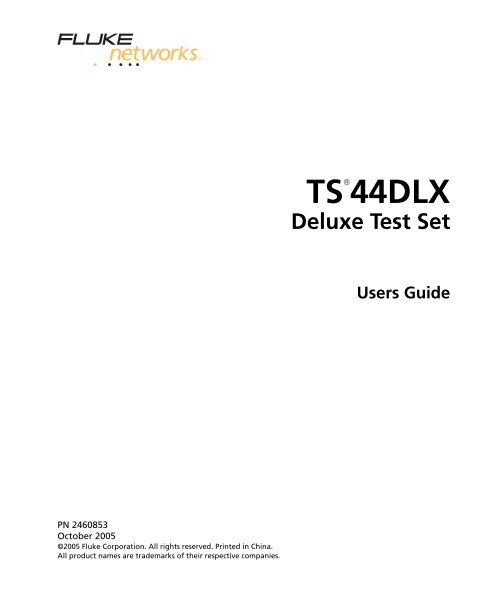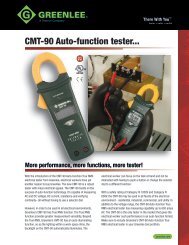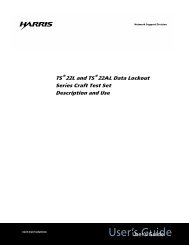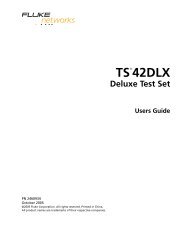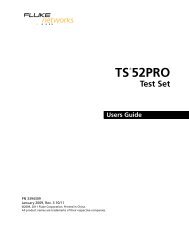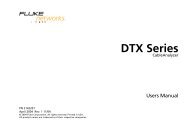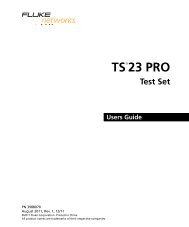TS44 Manual - Datacomtools
TS44 Manual - Datacomtools
TS44 Manual - Datacomtools
Create successful ePaper yourself
Turn your PDF publications into a flip-book with our unique Google optimized e-Paper software.
TS ® 44DLX<br />
Deluxe Test Set<br />
Users Guide<br />
PN 2460853<br />
October 2005<br />
©2005 Fluke Corporation. All rights reserved. Printed in China.<br />
All product names are trademarks of their respective companies.
LIMITED WARRANTY AND LIMITATION OF LIABILITY<br />
Each Fluke Networks product is warranted to be free from defects in material and workmanship under<br />
normal use and service. The warranty period for the mainframe is 3 years and begins on the date of purchase.<br />
Parts, accessories, product repairs and services are warranted for 90 days, unless otherwise stated. Ni-Cad, Ni-<br />
MH and Li-Ion batteries, cables or other peripherals are all considered parts or accessories. The warranty<br />
extends only to the original buyer or end user customer of a Fluke Networks authorized reseller, and does<br />
not apply to any product which, in Fluke Networks’ opinion, has been misused, abused, altered, neglected,<br />
contaminated, or damaged by accident or abnormal conditions of operation or handling. Fluke Networks<br />
warrants that software will operate substantially in accordance with its functional specifications for 90 days<br />
and that it has been properly recorded on non-defective media. Fluke Networks does not warrant that<br />
software will be error free or operate without interruption.<br />
Fluke Networks authorized resellers shall extend this warranty on new and unused products to end-user<br />
customers only but have no authority to extend a greater or different warranty on behalf of Fluke Networks.<br />
Warranty support is available only if product is purchased through a Fluke Networks authorized sales outlet<br />
or Buyer has paid the applicable international price. Fluke Networks reserves the right to invoice Buyer for<br />
importation costs of repair/replacement parts when product purchased in one country is submitted for repair<br />
in another country.<br />
Fluke Networks warranty obligation is limited, at Fluke Networks option, to refund of the purchase price,<br />
free of charge repair, or replacement of a defective product which is returned to a Fluke Networks<br />
authorized service center within the warranty period.<br />
To obtain warranty service, contact your nearest Fluke Networks authorized service center to obtain return<br />
authorization information, then send the product to that service center, with a description of the difficulty,<br />
postage and insurance prepaid (FOB destination). Fluke Networks assumes no risk for damage in transit.<br />
Following warranty repair, the product will be returned to Buyer, transportation prepaid (FOB destination).<br />
If Fluke Networks determines that failure was caused by neglect, misuse, contamination, alteration, accident<br />
or abnormal condition of operation or handling, or normal wear and tear of mechanical components, Fluke<br />
Networks will provide an estimate of repair costs and obtain authorization before commencing the work.<br />
Following repair, the product will be returned to the Buyer transportation prepaid and the Buyer will be<br />
billed for the repair and return transportation charges (FOB Shipping point).<br />
THIS WARRANTY IS BUYER’S SOLE AND EXCLUSIVE REMEDY AND IS IN LIEU OF ALL OTHER WARRANTIES,<br />
EXPRESS OR IMPLIED, INCLUDING BUT NOT LIMITED TO ANY IMPLIED WARRANTY OR MERCHANTABILITY OR<br />
FITNESS FOR A PARTICULAR PURPOSE. FLUKE NETWORKS SHALL NOT BE LIABLE FOR ANY SPECIAL, INDIRECT,<br />
INCIDENTAL OR CONSEQUENTIAL DAMAGES OR LOSSES, INCLUDING LOSS OF DATA, ARISING FROM ANY<br />
CAUSE OR THEORY.<br />
Since some countries or states do not allow limitation of the term of an implied warranty, or exclusion or<br />
limitation of incidental or consequential damages, the limitations and exclusions of this warranty may not<br />
apply to every buyer. If any provision of this Warranty is held invalid or unenforceable by a court or other<br />
decision-maker of competent jurisdiction, such holding will not affect the validity or enforceability of any<br />
other provision.<br />
4/04-3<br />
Fluke Networks<br />
PO Box 777<br />
Everett, WA 98206-0777<br />
USA
Table of Contents<br />
Title<br />
Introduction ...................................................................................................................................................... 1<br />
Registration ....................................................................................................................................................... 1<br />
Contacting Fluke Networks .............................................................................................................................. 1<br />
Safety Information ............................................................................................................................................ 2<br />
Design Features ................................................................................................................................................. 2<br />
Physical Characteristics ..................................................................................................................................... 2<br />
Housing ...................................................................................................................................................... 2<br />
Belt Clips ..................................................................................................................................................... 2<br />
Line Cords ................................................................................................................................................... 3<br />
Battery ........................................................................................................................................................ 3<br />
Speaker and Speakerphone Microphone .................................................................................................4<br />
Audio Controls ........................................................................................................................................... 4<br />
Keypad Controls and Indicators ................................................................................................................ 4<br />
Operation .......................................................................................................................................................... 9<br />
Talk/Monitor Switch .................................................................................................................................. 9<br />
Operating the Test Set in Monitor Mode .................................................................................................9<br />
Operating the Test Set in Talk Mode ....................................................................................................... 9<br />
Originating a Call ............................................................................................................................... 9<br />
Disconnecting a Call ........................................................................................................................... 10<br />
Answering a Call ................................................................................................................................. 10<br />
Ground Start ....................................................................................................................................... 10<br />
Data Lockout Operation ............................................................................................................................ 10<br />
Data Safe Practices ..................................................................................................................................... 10<br />
Data Lockout Override Operation ............................................................................................................ 11<br />
High Voltage Lockout Operation ............................................................................................................. 12<br />
Configuring Your Test Set ......................................................................................................................... 12<br />
Last Number Redial ............................................................................................................................ 12<br />
Program Speed Dialing Numbers ...................................................................................................... 12<br />
Storing a Number When in Monitor Mode (Preferred Method) ..................................................... 12<br />
Storing the Last Number Dialed ........................................................................................................ 13<br />
Storing a Number You are Calling .................................................................................................... 13<br />
Putting a Pause in a Stored Number .................................................................................................13<br />
Dialing a Stored Number ................................................................................................................... 13<br />
Hook Flash Duration ........................................................................................................................... 13<br />
Pause Duration ................................................................................................................................... 14<br />
Exclusive Receive Only Loud Speaker ................................................................................................ 14<br />
Page<br />
i
<strong>TS44</strong>DLX Deluxe Test Set<br />
Users Guide<br />
Speaker Timeout .................................................................................................................................14<br />
Factory Defaults ..................................................................................................................................15<br />
Maintenance ......................................................................................................................................................15<br />
Replacing the Battery ................................................................................................................................15<br />
Replacing or Relocating the Belt Clip .......................................................................................................16<br />
Replacing the Line Cord .............................................................................................................................16<br />
Removing the Old Line Cord ..............................................................................................................17<br />
Installing a New Line Cord .................................................................................................................18<br />
Accessories ..................................................................................................................................................19<br />
Specifications .....................................................................................................................................................19<br />
ii
TS ® 44DLX Deluxe Test Set<br />
Introduction<br />
The <strong>TS44</strong>DLX Deluxe Test Set is an analog test<br />
telephone used by installers, repair technicians and<br />
other authorized personnel to test copper wire voice<br />
subscriber lines. In addition to providing standard offhook<br />
operations, such as dialing and voice<br />
communications, the <strong>TS44</strong>DLX Deluxe model has an<br />
on-hook Monitor Mode that lets the operator listen to<br />
the line without disturbing any voice or data signals<br />
present. The test set has a speaker for hands-free<br />
listening. The test set also has a speakerphone that<br />
allows two way conversations while freeing up the<br />
operator’s hands for other tasks.<br />
In today’s telecommunications environment, a large<br />
number of subscriber lines carry data services. The data<br />
services are in the same distribution facilities as voice<br />
services. It is not always easy to tell the difference<br />
between data and voice services. The <strong>TS44</strong>DLX Deluxe<br />
Test Set uses unique, patented circuitry that prevents<br />
disruption of digital data services if the test set is<br />
unintentionally connected to a data line.<br />
Registration<br />
Contacting Fluke Networks<br />
www.flukenetworks.com<br />
support@flukenetworks.com<br />
+1-425-446-4519<br />
• Australia: 61 (2) 8850-3333 or 61 3 9329 0244<br />
• Beijing: 86 (10) 6512-3435<br />
• Brazil: 11 3044 1277<br />
• Canada: 1-800-363-5853<br />
• Europe: +44-(0)1923-281-300<br />
• Hong Kong: 852 2721-3228<br />
• Japan: 03-3434-0510<br />
• Korea: 82 2 539-6311<br />
• Singapore: 65-6799-5566<br />
• Taiwan: (886) 2-227-83199<br />
• USA: 1-800-283-5853<br />
• Anywhere in the world: +1-425-446-4519<br />
Visit our website for a complete list of phone numbers.<br />
Registering your product with Fluke Networks gives<br />
you access to valuable information on product updates,<br />
troubleshooting tips, and other support services. To<br />
register, fill out the online registration form on the<br />
Fluke Networks website at www.flukenetworks.com/<br />
registration.<br />
1
<strong>TS44</strong>DLX Deluxe Test Set<br />
Users Guide<br />
Safety Information<br />
The following IEC symbols are used either on the test<br />
set or in the manual:<br />
W<br />
X<br />
.<br />
~<br />
Warning: Risk of personal injury. See the<br />
manual for details.<br />
Caution: Risk of damage or destruction to<br />
equipment or software. See the manual<br />
for details.<br />
Warning: Risk of electric shock.<br />
Earth ground<br />
Do not put products containing circuit<br />
boards into the garbage. Dispose of<br />
circuits boards in accordance with local<br />
regulations.<br />
WXWarning<br />
Do not use the test set if it is damaged.<br />
Before you use the test set, inspect the case.<br />
Look for cracks or missing plastic. Pay<br />
particular attention to the insulation<br />
surrounding the connectors.<br />
If this product is used in a manner not<br />
specified by the manufacturer, the<br />
protection provided by the product may be<br />
impaired.<br />
Design Features<br />
Design features of the <strong>TS44</strong>DLX Deluxe Test Set<br />
include:<br />
• Data detection in Monitor mode<br />
• DataSafe TM in Monitor mode<br />
• Data detection and lockout in Talk mode<br />
• Data lockout override<br />
• High impedance in Monitor mode<br />
• High voltage protection<br />
• Last number redial up to 23 digits<br />
• Microphone mute<br />
• PBX pause key<br />
• Continuous polarity indication in Talk mode<br />
• Two-way speakerphone<br />
• Receive-only loud speaker<br />
• Speed dialing for ten 23-digit numbers<br />
• Tone and pulse dialing<br />
• Hook flash<br />
• Line voltage test<br />
• Low loop current test<br />
• Low battery indication<br />
• Relocatable belt clip<br />
• Field-replaceable belt clip, battery, and line cord<br />
• Weatherproof case<br />
• High voltage lockout in Talk mode<br />
• Software upgradable<br />
Physical Characteristics<br />
Housing<br />
See Figure 1.<br />
The <strong>TS44</strong>DLX Deluxe Test Set housing is made of highimpact<br />
plastic. The test set provides rugged service and<br />
withstands the rough handling and shocks associated<br />
with field use. The housing permits operation in bad<br />
weather, such as heavy rain or dust storms.<br />
Belt Clips<br />
See Figure 1.<br />
The belt clip can be located at either or both ends of<br />
the housing. It has a spring-loaded, locking clip that<br />
assures a secure connection to belt loops and D-rings.<br />
Both forward folding and backwards folding versions<br />
of the belt clip may be installed. The test set can be<br />
hung by the belt clip in one of two ways: (1) with<br />
keypad and speakerphone facing the user for<br />
convenient access or (2) with the transmitter facing the<br />
user.<br />
The belt clips may be replaced or relocated in the field.<br />
See “Replacing or Relocating the Belt Clip” on page 16.<br />
2
Physical Characteristics<br />
Figure 1. Physical Characteristics<br />
bfp01.eps<br />
Line Cords<br />
See Figure 1.<br />
The test set has a field replaceable line cord. The line<br />
cord is attached through a rubber strain relief at the<br />
transmitter end of the test set. Several different<br />
configurations of line cords are available. See<br />
“Accessories” on page 19 for model numbers.<br />
Battery<br />
See Figure 1.<br />
WCaution<br />
Use caution when handling batteries. Do<br />
not let the terminals short together. Dispose<br />
of batteries properly to ensure terminals<br />
cannot short. Disposal may be restricted by<br />
local laws.<br />
The test set’s battery compartment makes battery<br />
replacement easy. See “Replacing the Battery” on page<br />
15.<br />
Note<br />
If the test set fails to operate properly, first<br />
replace the battery and retest before sending<br />
the test set in for repair.<br />
A 9 V alkaline battery must be installed for the test set<br />
to operate. Do not use rechargeable batteries.<br />
The battery performs two main functions:<br />
• It powers the test set when on-hook.<br />
• It supplies supplementary current to the speaker (if<br />
on) when the test set is off-hook.<br />
3
<strong>TS44</strong>DLX Deluxe Test Set<br />
Users Guide<br />
When the LO BATT LED begins flashing, the battery,<br />
has anywhere from several hours to several days of life<br />
remaining depending on how often the speaker is<br />
used.<br />
See “Replacing the Battery” on page 15 for instructions<br />
on changing the battery.<br />
If the test set stops working, remove the 9 V battery,<br />
wait at least 40 seconds, then replace the battery. This<br />
resets the test set. Use the same battery if you know it<br />
is good or use a new battery if you are not sure. If it still<br />
doesn’t work, contact Fluke Networks Technical<br />
Support.<br />
Speaker and Speakerphone Microphone<br />
See Figure 1.<br />
The speaker and speakerphone microphone are<br />
located on the keypad side of the test set. The speaker<br />
draws more current than any other circuit in the test<br />
set. The battery lasts longer if the speaker is used in<br />
moderation.<br />
Audio Controls<br />
See Figure 2.<br />
The three audio control keys are located on the inside<br />
handle of the test set between the handset receiver<br />
and the handset microphone. These controls let the<br />
operator switch between the handset and speakerphone,<br />
mute the active microphone, and control the<br />
volume of the received audio signal. Table 1 describes<br />
the audio control keys.<br />
WWarning<br />
Never hold the speaker against your ear<br />
when it is on, or when turning it on or off.<br />
Sounds emitted by the speaker can be loud<br />
enough to damage your hearing.<br />
Keypad Controls and Indicators<br />
See Figure 3.<br />
The keypad has 19 keys that are recessed into the<br />
housing. The recessed bezel protects the keypad and<br />
helps prevent accidental key presses. Table 2 describes<br />
the keys and other indicators on the test set.<br />
Figure 2. Audio Control Keys<br />
bfp02.eps<br />
4
Physical Characteristics<br />
Table 1. Test Set Audio Control Keys<br />
Key Description (refer to Figure 2)<br />
MUTE<br />
VOL<br />
(Volume)<br />
SPKR<br />
(Speaker)<br />
The MUTE key functions only when the test set is off-hook. When the test set is off-hook and being<br />
used as a handset, pressing the MUTE key shuts off the handset’s microphone. This is useful in noisy<br />
environments such as near heavy traffic. With the mute on, ambient noise is not picked up by the<br />
test set’s microphone and therefore not transmitted to the speaker. When the mute is on, it is easier<br />
to hear the person at the other end of the line and easier to hear static or noise on the line. Pressing<br />
the MUTE key again turns the microphone on.<br />
When the test set is off-hook and is in Speakerphone mode, pressing the MUTE key will shut off the<br />
speakerphone’s microphone and will put the test set into a Receive-Only Loud Speaker mode. This is<br />
a better mode for troubleshooting than Speakerphone mode. Pressing the MUTE key again will turn<br />
the speakerphone microphone on.<br />
The test set may be configured to operate exclusively in Receive Only Loud Speaker mode. When in<br />
this mode, the MUTE key has no effect on test set operation while in loudspeaker mode. See<br />
“Configuring Your Test Set” on page 12.<br />
When the mute is on, the MUTE LED flashes.<br />
Pressing the VOL key switches the active receiver’s sound level between normal and high volume.<br />
This occurs in Monitor mode and Talk mode. The state of the VOL key is preserved when the active<br />
receiver is changed. For example, with the handset receiver volume set to high, if you switch to the<br />
speaker, it will also be set to high volume. The VOL key affects only the volume of received signals. It<br />
does not affect the volume of transmitted signals.<br />
The SPKR key turns the test set’s speaker on and off. It functions in both Talk and Monitor modes.<br />
In Monitor mode, if the test set is being used as a handset, pressing the SPKR key turns on the<br />
speaker. This lets you monitor a line while working at a distance from the test set.<br />
If the test set is off-hook and is being used as a handset, pressing the SPKR key turns on the<br />
Speakerphone. The handset microphone and receiver are shut off and the speakerphone<br />
microphone and speaker are enabled. This mode is intended for two-way, hands-free conversation.<br />
You may also configure the test set to operate exclusively in Receive Only Loud Speaker mode (see<br />
“Configuring Your Test Set” on page 12). For test sets configured as Receive Only Loud Speaker, if<br />
the test set is off-hook and is being used as a handset, pressing the SPKR key turns on the Receive<br />
Only Loud Speaker. This mode is intended for listening to the line, hands free.<br />
5
<strong>TS44</strong>DLX Deluxe Test Set<br />
Users Guide<br />
Figure 3. <strong>TS44</strong>DLX Deluxe Keypad and Overlay<br />
bfp03.eps<br />
Table 2. Test Set Keypad Control and Indicators<br />
Key or<br />
Indicator Description (refer to Figure 3)<br />
Numeric<br />
Keypad<br />
RCL (Recall)<br />
key<br />
FLASH key<br />
(Hook-Flash)<br />
LNR (Last<br />
Number<br />
Redial) key<br />
PAUSE key<br />
The numeric keypad is used to dial telephone numbers and make function selections. The numeric<br />
keypad includes 12 standard dialing keys including the star ( ∗<br />
) and the pound (#) keys. The seven<br />
special purpose keys are described below.<br />
The RCL key is used for the storing and recalling of repertory dialing numbers. See “Program<br />
Speed Dialing Numbers” on page 12.<br />
The FLASH key interrupts loop current for a timed duration. The FLASH key operates only when<br />
the test set is off-hook. When pressed, the FLASH key interrupts loop current for the programmed<br />
hook-flash duration. See “Hook Flash Duration” on page 13.<br />
The LNR key redials the number most recently dialed. See “Last Number Redial” on page 12.<br />
The PAUSE key inserts a timed pause into a stream of dialed digits. The PAUSE key is commonly<br />
used in combination with speed dial numbers that will be dialed out through a PBX. The duration<br />
of the pause is user programmable. See “Pause Duration” on page 14.<br />
-continued-<br />
6
Physical Characteristics<br />
Table 2. Test Set Keypad Control and Indicators (continued)<br />
Key or<br />
Indicator Description (refer to Figure 3)<br />
STORE/PROG<br />
TONE/PULSE<br />
key<br />
TEST key<br />
Light<br />
Emitting<br />
Diodes<br />
(LEDs)<br />
MUTE LED<br />
LO BATT<br />
(low battery)<br />
LED<br />
The STORE/PROG key is used for storing speed dialing numbers and for programming special test<br />
set functions.<br />
The TONE/PULSE key switches the test set between tone and pulse dialing. The TONE/PULSE key is<br />
active only when the test set is off-hook. Any time the test set goes off-hook, it is automatically set<br />
to tone dialing. Once off-hook, pressing the TONE/PULSE key changes the dialing mode to pulse<br />
dialing. Pressing the key again will switch back to tone dialing.<br />
The TEST key performs three different tests. Two of the tests are performed when the test set is<br />
on-hook and one of the tests is performed when the test set is off-hook. The test results are<br />
meaningful only if the unit’s test leads are connected to tip and ring of a subscriber line.<br />
When the test set is on-hook, pressing the TEST key causes two tests to be executed. Both tests are<br />
performed simultaneously. When the TEST key is pressed, the test set searches for data on the<br />
telephone line. If the test set detects data, the data-detect alarm sounds for about 5 seconds<br />
letting you know there is data on the line. If there is no data, the test set sounds a brief<br />
confirmation tone indicating the test was run and no data was detected. Simultaneously, the test<br />
set measures the dc voltage across Tip and Ring and displays, by LED, whether the voltage is high,<br />
low or normal. The indications provided by this test are described under “HI/LO Voltage LEDs”.<br />
The purpose of the test is to indicate the approximate dc voltage on the line. For example, the<br />
user runs the test, expecting a normal battery feed of -48 Vdc on a line; instead, the amber LED<br />
flashes indicating the dc voltage is lower than a normal CO battery. This indicates the test set may<br />
be connected to the wrong pair, or there may be a problem with the line.<br />
The POL LEDs double as low loop current indicators. When off-hook and the TEST key is pressed, if<br />
the current reading is below 23 mA, the LED corresponding to the line polarity will flash for 5<br />
seconds. If the loop current is normal, the LED will light solid. Low loop current may indicate a<br />
problem on the line.<br />
All LED indicators are located on the keypad inside the recessed area.<br />
The MUTE LED flashes when the mute function is activated.<br />
The LO BATT LED flashes when the 9 V battery is nearly discharged. The LED is active only in<br />
operating modes that use the battery.<br />
-continued-<br />
7
<strong>TS44</strong>DLX Deluxe Test Set<br />
Users Guide<br />
Table 2. Test Set Keypad Control and Indicators (continued)<br />
Key or<br />
Indicator Description (refer to Figure 3)<br />
POL/LO mA<br />
(Polarity/ low<br />
mA) LEDs<br />
Electronic<br />
Ringer<br />
HI/LO VDC<br />
(high/low<br />
Vdc) LEDs<br />
Notes<br />
The <strong>TS44</strong>DLX Deluxe Test Set is not polarity sensitive, and will function in either polarity.<br />
The POL LEDs will not light if the test set is on-hook or when the speaker is on.<br />
When the test set is off-hook, one of the two POL LEDs light to indicate the dc polarity of the line.<br />
The green POL LED lights if the red test lead is connected to the Ring (negative) side of the line<br />
and the black test lead is connected to the Tip (positive) side of the line. The red POL LED lights if<br />
the test leads are reversed; that is, the red test lead is connected to the Tip (positive) side and the<br />
black test lead is connected to the Ring (negative) side.<br />
The POL LEDs double as low loop current indicators. When off-hook and the TEST key is pressed, if<br />
the current reading is below 23 mA, the LED corresponding to the line polarity flashes for 5<br />
seconds. If the loop current is normal, the LED lights solid. Low loop current may indicate a<br />
problem on the line.<br />
The electronic ringer is enabled while the test set is on-hook.<br />
When the test set is on-hook and the TEST key is pressed, the test set measures the dc voltage<br />
across Tip and Ring and indicates the voltage level as follows:<br />
Voltage Range<br />
Indication<br />
0 V to 2 V LO Vdc LED lights for 5 seconds<br />
2 V to 42 V LO Vdc LED blinks for 5 seconds<br />
42 V to 53 V (Normal CO battery voltage) Both the LO Vdc and HI Vdc LEDs flash once<br />
53 V to 140 V HI Vdc LED blinks for 5 seconds<br />
Above 140 V<br />
HI Vdc LED lights for 5 seconds<br />
For voltages that cause either LED to light solidly for 5 seconds, the test set will not allow off-hook<br />
operation.<br />
If the test set is placed in Talk mode on a loop with more than 140 Vdc, the test set locks out and<br />
the HI Vdc LED remains lit until the test set is placed in Monitor mode or the voltage drops below<br />
140 V.<br />
8
Operation<br />
Operation<br />
The test set has two basic modes of operation: Talk<br />
mode and Monitor mode. Talk mode is used for offhook<br />
operations (such as dialing verification, automatic<br />
number identification, and audio quality verification).<br />
Monitor mode is for audio monitoring of the Tip and<br />
Ring pair while on-hook. In Monitor mode, the test set<br />
has a high input impedance, which allows monitoring<br />
of the line without disrupting conversations or data, if<br />
present.<br />
WCaution<br />
When testing circuits that are close to a<br />
battery source, clipping onto a line may case<br />
loud pops in the receiver. Holding the<br />
receiver tightly against your ear may cause<br />
acoustic shock. The test set is designed to<br />
rest comfortably on the shoulder with some<br />
space between the receiver and the ear. It<br />
should be used in this position when<br />
working close to a battery source.<br />
Shorting the Tip and Ring leads together<br />
while connected to a data line will disrupt<br />
data on the line.<br />
Talk/Monitor Switch<br />
See Figure 1.<br />
The Talk/Monitor switch is a rocker switch located on<br />
the side of the test set. The T position puts the test set<br />
into Talk mode. The M position puts the test set into<br />
Monitor mode.<br />
Operating the Test Set in Monitor Mode<br />
In Monitor mode, the test set is always on-hook. The<br />
test set draws no direct current from the line and it<br />
transmits no signals to the line. In this mode, the test<br />
set has a high ac input impedance, which allows<br />
listening for audio signals without disrupting<br />
conversations or data signaling that may be present.<br />
Either the handset receiver or the speaker can be used<br />
to monitor a line.<br />
In the Monitor mode, the test set is typically used for<br />
one or more of the following procedures:<br />
• Verification that a line is idle when looking for a<br />
line to borrow<br />
• Listening for noise on the line<br />
• Hunting for tracer tones<br />
• Testing for high frequency data on the line by<br />
using the TEST key.<br />
• Testing for dc voltage on the line by using the TEST<br />
key.<br />
Operating the Test Set in Talk Mode<br />
In Talk mode, the test set performs a brief test for highspeed<br />
data and talk battery on the line. If high-speed<br />
data is detected, the test set generates an audio alarm<br />
and remain on-hooks. If high-speed data is not<br />
detected and talk battery is present, the test set goes<br />
off-hook. When off-hook, the test set operates like a<br />
standard telephone and is typically used to verify the<br />
proper operation of a voice telephone line or to<br />
establish temporary communications on a “borrowed<br />
pair”.<br />
Originating a Call<br />
1 Set the Talk/Monitor switch to M.<br />
2 Clip the test set to Tip and Ring of a subscriber<br />
loop.<br />
3 Monitor (listen to) the line to verify it is idle.<br />
4 If not idle, disconnect the test set from the line.<br />
5 If the line is idle, set the Talk/Monitor switch to T.<br />
The test set automatically tests for high-speed data<br />
and talk battery on the line.<br />
6 If data is detected, the test set will not go off-hook<br />
(will lockout) and will alarm, indicating the<br />
presence of data. Try another line.<br />
-continued-<br />
9
<strong>TS44</strong>DLX Deluxe Test Set<br />
Users Guide<br />
7 If there is no data and talk battery is present, the<br />
test set goes off-hook and draws dial tone.<br />
Note<br />
The test set will not go off-hook if the line<br />
voltage exceeds 140 Vdc.<br />
8 Dial the desired number.<br />
Disconnecting a Call<br />
To disconnect a call, set the Talk/Monitor switch to M or<br />
remove the test leads from the line.<br />
Answering a Call<br />
1 If a ringing signal is received, set the Talk/Monitor<br />
switch to T. The test set automatically tests for<br />
high-speed data on the line.<br />
2 If there is no data and talk battery is present, the<br />
test set goes off-hook and draws dial tone.<br />
Note<br />
The <strong>TS44</strong>DLX Deluxe will not go off-hook if the<br />
line voltage exceeds 140 Vdc.<br />
3 If data is detected, the test set will lockout and<br />
alarm, indicating data is present.<br />
4 To go off-hook with data present, press the<br />
Override key sequence (see “Data Lockout<br />
Override Operation” on page 11).<br />
Ground Start<br />
Ground start lines are typically found on PBX<br />
installations. To activate an idle ground start telephone<br />
line, do the following:<br />
1 Set the Talk/Monitor switch to M, and connect the<br />
test leads to Tip and Ring of the ground start line.<br />
With a third wire, temporarily short the Tip side of<br />
the line to earth ground. A wire with an alligator<br />
clip at each end is often used for this. Do not allow<br />
clips to short network connections.<br />
2 With the short to earth ground in place, set the<br />
Talk/Monitor switch to T. When dial tone is<br />
received, remove the third wire from earth. The<br />
circuit is now ready for dialing.<br />
Data Lockout Operation<br />
With the increase in high capacity data lines in the<br />
distribution system comes the greater risk of disrupting<br />
data services when working on analog lines. The test<br />
set is designed to be used by Outside Plant and Central<br />
Office technicians to perform their normal duties while<br />
greatly reducing the possibility of accidentally<br />
disrupting data service.<br />
Accidentally going off-hook on a data line while<br />
searching for talk battery or dial tone on an unmarked<br />
terminal block or cable splice could bring down a highcapacity<br />
data lines. To prevent this, the test set provides<br />
an automatic data lockout function. When the test set,<br />
with its Talk/Monitor switch in the T position, is<br />
connected to a Tip and Ring pair, it automatically tests<br />
the line for high-speed data (data signals that are<br />
above the human audio range) before going off-hook.<br />
If data is detected, the test set locks out, preventing<br />
itself from going off-hook, and it provides a continuous<br />
audio alarm indicating it has detected data.<br />
When the test set is locked out, it remains on-hook, it<br />
does not draw direct current from the line, and it<br />
presents a high ac impedance to the line to prevent<br />
disruption of data. The test set can detect and protect<br />
the following data services: ISDN BRI, ISDN PRI, 56k<br />
DDS, SW56, T1 and E1, HDSL, IDSL, SDSL, ADSL DMT,<br />
ADSL CAP, and ADSL LITE.<br />
Data Safe Practices<br />
Always monitor the line for an audible signal before<br />
attempting to go off-hook to draw dial tone. The data<br />
detect circuitry on the test set is designed to detect<br />
data signals above the human audio range. To detect<br />
data signals within the human audio range, such as<br />
produced by voiceband modems and subrate DDS<br />
transceivers, you must listen to the line using the test<br />
set’s audio monitoring capability. If you hear the hiss of<br />
a voice band modem or low frequency data transceiver,<br />
do not move the Talk/Monitor switch to T. If you do<br />
switch to T, the test set will not lockout because it does<br />
not detect low frequency data. It will go off hook and<br />
will interfere with the voice band modem or data<br />
transceiver. To avoid this, try another line or wait until<br />
the line is idle.<br />
10
Operation<br />
Data detection is a two part process. The first part<br />
requires listening to the line for audible data traffic in<br />
Monitor mode as described above. If the line is quiet,<br />
then the second part is to use the test set’s data detect<br />
capability to determine if there is data above the<br />
human audio range on the line. This can be done in<br />
one of two ways.<br />
• You can test for high-speed data with the test set<br />
still in Monitor mode by pressing the TEST key. If<br />
there is high-speed data on the pair, the test set<br />
generates an alarm for about 5 seconds. If there is<br />
no data on the line, the test set generates a brief<br />
confirmation tone. If the warning alarm is not<br />
sounded, then switch the test set to Talk mode,<br />
and it will go off-hook.<br />
• You can test for data by switching the Talk/<br />
Monitor switch to T. The test set automatically<br />
performs a brief test for high-speed data. If there<br />
is data on the line, the test set locks out, (remains<br />
on-hook) and generates a data warning alarm. If<br />
there is no data on the line, the test set goes offhook.<br />
When going from pair to pair searching for tracer tone<br />
or dial tone it is best to connect the test set to Tip and<br />
Ring of the pairs. Avoid the practice, either in Talk or<br />
Monitor mode, of clipping one lead of the test set to<br />
ground, and using the other lead to search for tracer<br />
tone or dial tone on a block. This may create an<br />
electrical imbalance on a data line that will disrupt<br />
service. Once you find the voice line you are searching<br />
for then it is OK to test Tip to ground or Ring to ground<br />
on that line.<br />
Be careful not to short the test leads together when<br />
connecting to a data line (or any line for that matter),<br />
as this could bring down the service.<br />
It is best to put the test set in Monitor mode when<br />
troubleshooting a line, searching for capacitance kicks,<br />
RF signals, craft provided tones, etc.<br />
Data Lockout Override Operation<br />
Normally, when the test set detects data, it means the<br />
operator has accidentally connected to a high-speed<br />
data line and should immediately disconnect from the<br />
line to avoid disrupting the data service. But in some<br />
cases the operator must go off-hook on a specific line<br />
even though the test set indicates that the line is a data<br />
line.<br />
The following are scenarios where the operator may<br />
wish to override a data lockout:<br />
• When there is false data detection due to RF<br />
pickup on a line that is near an AM radio<br />
broadcast antenna. The RF induced in the line may<br />
appear to be data.<br />
• When performing a ground start, the test set may<br />
generate the data alarm when the Talk/Monitor<br />
switch is in the T position. This is because ground<br />
start lines are unbalanced before startup and thus<br />
are prone to picking up a lot of noise which may<br />
appear to be data to the test set. If this occurs, use<br />
the override function to go off-hook on a ground<br />
start line.<br />
Telephone lines near AM radio broadcast facilities, pick<br />
up the RF signals from the broadcast antennas.<br />
Normally this isn’t a problem for the test set. If the line<br />
is well balanced, the test set will not see the RF signal<br />
because it is a common mode (longitudinal) signal. But<br />
if the line is unbalanced, part of the RF signal will be<br />
converted to a differential (metallic) signal. If the signal<br />
amplitude is high enough, it may be detected as highspeed<br />
data by the test set. If you know for sure you are<br />
on such a line, use the unit’s override capability to go<br />
off-hook.<br />
The data lockout override can be activated only when<br />
the Talk/Monitor switch is in the T position. To activate<br />
the override, press the STORE/PROG key then the TEST<br />
key. If dc voltage is present, the test set goes off-hook.<br />
To go back on-hook, unclip the test set’s test leads from<br />
the line or put the test set into Monitor mode. The<br />
override key sequence must be executed each time you<br />
want to take a locked-out test set off-hook.<br />
11
<strong>TS44</strong>DLX Deluxe Test Set<br />
Users Guide<br />
High Voltage Lockout Operation<br />
The <strong>TS44</strong>DLX Deluxe is designed for use by Outside<br />
Plant and Central Office technicians in environments<br />
where analog voice lines co-exist with lines that carry<br />
high dc voltage.<br />
Accidentally going off-hook on a line carrying a high dc<br />
voltage can damage the power supply feeding the line.<br />
To prevent this, the <strong>TS44</strong>DLX Deluxe provides an<br />
automatic high-voltage lockout function. When a<br />
<strong>TS44</strong>DLX Deluxe is connected to a Tip and Ring pair<br />
with its Talk/Monitor switch in the T position, it<br />
measures the voltage on the line before going offhook.<br />
If the measured voltage exceeds 140 Vdc, the test<br />
set locks out, preventing itself from going off-hook.<br />
The high-voltage lockout condition is indicated by a<br />
solidly lit HI Vdc LED. In the event of a high voltage<br />
lockout, the Talk/Monitor switch should be set back to<br />
the M position, and the test set leads should be<br />
carefully removed from the line.<br />
WCaution<br />
Do not short the test leads to each other<br />
while it is connected to a line carrying high<br />
voltage.<br />
Configuring Your Test Set<br />
Last Number Redial<br />
In the Tone or Pulse dialing mode, the last number<br />
dialed can be automatically redialed by pressing the<br />
LNR key after going on-hook and then back off-hook.<br />
To redial a number, the LNR key should be the first key<br />
pressed after going back off-hook.<br />
In tone dialing mode, the dialing keys that may be<br />
stored in LNR memory include 1,2,3,4,5,6,7,8,9,0,*,#<br />
and PAUSE. If the star ( ∗ ) and pound (#) keys are<br />
pressed in pulse mode they are ignored. The star ( ∗<br />
)<br />
and pound (#) keys will not be redialed when the test<br />
set is in pulse mode even if the redial memory includes<br />
star ( ∗<br />
) and pound (#).<br />
Program Speed Dialing Numbers<br />
While in Monitor mode, the test set allows the storage<br />
of ten speed dialing numbers in ten memory locations<br />
(0 through 9). Each location stores up to 23 digits. If an<br />
attempt is made to store more than 23 digits, only the<br />
first 23 are stored. The PAUSE key is accepted as a<br />
dialing digit when storing numbers.<br />
Storing a Number When in Monitor Mode<br />
(Preferred Method)<br />
1 Set the Talk/Monitor switch to M.<br />
2 Press RCL.<br />
3 Using the dialing keypad, enter the number to be<br />
stored.<br />
4 Press the STORE/PROG key.<br />
5 Press a number key (0 through 9) to select the<br />
desired memory location. The test set gives a<br />
confirmation tone.<br />
Note<br />
If a non-dialing key is pressed while<br />
programming a number sequence, it will be<br />
ignored. Pressing RCL a second time exits the<br />
programming mode.<br />
If, after going off-hook, any dialing key is pressed, the<br />
LNR memory is cleared and the value of the pressed<br />
key is the first number stored in the cleared memory.<br />
The PAUSE key is considered a dialing key. If pressed, a<br />
pause is stored in the redial memory, taking up one of<br />
the 23 digit slots.<br />
12
Operation<br />
Storing the Last Number Dialed<br />
If you dial a number then go on-hook and then decide<br />
you want to save that number in speed dialing<br />
memory, do the following:<br />
1 Set the Talk/Monitor switch to M.<br />
2 Press RCL.<br />
3 Press LNR (Last Number Redial).<br />
4 Press the STORE/PROG key.<br />
5 Press a number key (0 through 9) to select the<br />
desired memory location. The test set gives a<br />
confirmation tone.<br />
Storing a Number You are Calling<br />
1 Connect the test set to a working telephone line,<br />
set the Talk/Monitor switch to T, and receive dial<br />
tone.<br />
2 Dial the number.<br />
3 Press the STORE/PROG key.<br />
4 Press a number key (0 through 9) to select the<br />
desired memory location.<br />
Putting a Pause in a Stored Number<br />
Note<br />
Each time the PAUSE key is pressed, it counts as<br />
one dialing digit.<br />
In some situations it may be necessary to put a pause<br />
between digits of a stored number, as when accessing a<br />
trunk through a PBX that requires a 9 to get an outside<br />
line. You can do this by pressing the PAUSE key at the<br />
point where the pause is required. For example, to<br />
store the number 9-555-1234, with a pause between<br />
the 9 and 5, enter 9[PAUSE]5551234. When the<br />
number is dialed out, there will be a pause between<br />
the 9 and 5. The duration of a pause is user<br />
programmable (see “Pause Duration” on page 14). You<br />
can insert a longer pause by pressing PAUSE more than<br />
once.<br />
Dialing a Stored Number<br />
1 Connect the test set to a working telephone line.<br />
2 Set the Talk/Monitor switch to T.<br />
3 When the test set goes off-hook, press RCL<br />
(RECALL) and then the number key (0 through 9)<br />
for the memory location. For example, to dial a<br />
number stored in location 5, press RCL and then 5.<br />
The number will be automatically dialed.<br />
Hook Flash Duration<br />
When the test set is off-hook, pressing the FLASH key<br />
causes a timed interruption of the loop current to<br />
occur. Some PBX setups or telephone office switches<br />
may use this signal to put a call on hold or to activate<br />
some special function. One flash is generated for each<br />
press of the key.<br />
To change the flash duration value:<br />
1 Set the Talk/Monitor switch to M.<br />
2 Press the STORE/PROG key.<br />
3 Press the FLASH key.<br />
4 Press a number key to select a hook flash time.<br />
Invalid entries are ignored. The test set gives a<br />
confirmation tone when the entry is accepted.<br />
Key Hook Flash Time<br />
1 100 ms<br />
2 200 ms<br />
3 300 ms<br />
4 400 ms<br />
5 500 ms<br />
6 600 ms (default)<br />
7 700 ms<br />
8 800 ms<br />
9 900 ms<br />
0 1000 ms<br />
13
<strong>TS44</strong>DLX Deluxe Test Set<br />
Users Guide<br />
Pause Duration<br />
The PBX Pause feature lets you insert a delay into<br />
speed dialing numbers. This is required when dialing<br />
out through a system that provides a second dial tone<br />
(such as PBX). Different PBX devices may require<br />
different pause durations to allow enough time for the<br />
second dial tone to be returned. The pause duration<br />
can be programmed.<br />
To change the PBX Pause duration:<br />
1 Set the Talk/Monitor switch to M.<br />
2 Press the STORE/PROG key.<br />
3 Press the PAUSE key.<br />
4 Press a number key to select a pause time. Invalid<br />
entries are ignored. The test set gives a<br />
confirmation tone when the entry is accepted.<br />
Key<br />
Pause Time<br />
1 2 seconds<br />
2 3 seconds<br />
3 4 seconds (default)<br />
4 5 seconds<br />
Exclusive Receive Only Loud Speaker<br />
In some situations (such as when searching for dial<br />
tone), you may prefer to have the test set’s speaker<br />
remain in Receive Only mode (muted) while<br />
transitioning in and out of Talk mode. To do this, you<br />
may configure the test set to operate with the speaker<br />
exclusively in a receive only mode.<br />
To enable/disable Exclusive Receive Only Loud Speaker<br />
mode:<br />
1 Set the Talk/Monitor switch to M.<br />
2 Press the STORE/PROG key.<br />
3 Press the MUTE key. The test set gives a<br />
confirmation tone.<br />
Speaker Timeout<br />
The speaker draws more current from the battery than<br />
any other circuit on the test set. The battery drains<br />
quickly when the speaker is left on continuously. To<br />
extend battery life, the test set has a timeout function<br />
that automatically turns off the speaker when the test<br />
set is on-hook. A timer starts whenever the test set is<br />
put on-hook. When the test set is off-hook, the timer<br />
will not start.<br />
If the test set is used as a handset in Monitor mode and<br />
if the test set’s receiver has been set to high volume,<br />
the battery is drained very quickly. To avoid this, the<br />
tester has a timeout function for the high volume state<br />
when in Monitor mode. After the timeout, the test set<br />
reverts to low volume.<br />
The speaker timeout duration is programmable while<br />
on-hook and 240 minutes (4 hours) while off-hook. The<br />
off-hook timeout cannot be changed. Remember, the<br />
longer the selected timeout duration the shorter the<br />
battery life.<br />
To change the speaker timeout duration:<br />
1 Set the Talk/Monitor switch to M.<br />
2 Press the STORE/PROG key.<br />
3 Press the SPKR key.<br />
4 Press a number key to select a duration. Invalid<br />
entries are ignored. The test set gives a<br />
confirmation tone when the entry is accepted.<br />
Key Speaker Timeout Duration<br />
1 2 minutes (default)<br />
2 5 minutes<br />
3 10 minutes<br />
4 20 minutes<br />
5 30 minutes<br />
6 40 minutes<br />
14
Maintenance<br />
Factory Defaults<br />
The Restore Defaults function lets you restore all<br />
programmable features to their original factory<br />
settings. This function does not clear stored telephone<br />
numbers. The defaults are:<br />
• Pause Duration: 4 seconds<br />
• Hook Flash Duration: 600 ms<br />
• Speaker Timeout: 2 minutes<br />
• Exclusive Only Loud Speaker: Disabled<br />
To restore the factory default values:<br />
1 Set the Talk/Monitor switch to M.<br />
2 Press the STORE/PROG key.<br />
3 Press the pound (#) key. The test set gives a<br />
confirmation tone when the entry is accepted.<br />
Maintenance<br />
WWarning<br />
Disconnect the clips from any metallic<br />
connections before performing any<br />
maintenance. Read all instructions<br />
completely and understand possible hazards<br />
to end user if repairs are not performed<br />
properly.<br />
Batteries are hazardous to handle. Do not<br />
allow the terminals to be shorted together.<br />
Severe burns or explosion can result if not<br />
handled properly. Dispose of battery<br />
properly to ensure contacts cannot short.<br />
Disposal may be restricted by local laws.<br />
WCaution<br />
Do not use CRC Cable Clean ® or any similar<br />
chlorinated solvent on the test set. Doing so<br />
will damage the test set.<br />
Replacing the Battery<br />
See Figure 4.<br />
To replace the 9 V battery:<br />
WCaution<br />
Be sure to account for all hardware<br />
removed. Loose or missing hardware could<br />
create a hazard for the end user. Be sure to<br />
replace the battery with a good 9 V alkaline<br />
or lithium battery or the test set will not<br />
operate properly.<br />
1 Disconnect the test set from the line and place on<br />
a flat work surface with the battery cover up.<br />
Note<br />
Battery cover screws are retained in the cover<br />
and will not come all the way out of the battery<br />
cover.<br />
2 Use a Phillips screwdriver to loosen only the four<br />
screws attaching the battery door cover to the<br />
back of the test set.Remove the battery door cover.<br />
Do not access or touch the printed circuit or other<br />
areas of the test set.<br />
3 Remove the old battery and properly discard.<br />
Make sure the terminals cannot short.<br />
4 Insert a new 9 V battery into the test set. When<br />
inserting batteries, observe the proper polarity.<br />
5 Check that all sealing surfaces are clean and mate<br />
properly for water resistant seal.<br />
6 Place the battery door cover on the test set and<br />
fasten the four screws securely. Do not over<br />
tighten the screws. The battery door screws should<br />
be torqued to a maximum of 0.904 N-m or 8 in-lb.<br />
15
<strong>TS44</strong>DLX Deluxe Test Set<br />
Users Guide<br />
Figure 4. Battery Replacement<br />
bfp04.eps<br />
Replacing or Relocating the Belt Clip<br />
See Figure 5.<br />
The belt clip assembly is field replaceable in the event<br />
of damage or prolonged wear. It also can be relocated<br />
to one of two locations. To order a replacement belt<br />
clip, contact your local Fluke Networks authorized<br />
distributor.<br />
To replace or relocate the belt clip assembly:<br />
1 Use a Phillips screwdriver to remove the screw that<br />
secures the belt clip to the test set housing at the<br />
keypad end.<br />
2 Remove the old belt clip and replace with a new<br />
one. Secure the belt clip assembly to the test set<br />
housing with the original screw.<br />
Figure 5. Belt Clip Replacement<br />
To install a second belt clip:<br />
1 Remove the blank insert from the test set.<br />
bfp05.eps<br />
2 Place the belt clip on the test set and secure with<br />
the screw supplied with the belt clip.<br />
3 Place the blank insert in the belt clip slot that is not<br />
being used.<br />
Replacing the Line Cord<br />
A worn out or damaged line cord can be replaced by<br />
the user. To obtain a replacement line cord, contact<br />
your local Fluke Networks authorized distributor.<br />
WWarning<br />
Read all instructions completely and<br />
understand possible hazards to end user if<br />
repairs are not performed properly.<br />
Disconnect test set clips from any metallic<br />
connections before performing this<br />
maintenance.<br />
16
Maintenance<br />
Removing the Old Line Cord<br />
To remove the old line cord:<br />
WCaution<br />
Be sure to account for all hardware<br />
removed. Loose or missing hardware could<br />
create a hazard for the end user.<br />
9 VOLT<br />
Notes<br />
Battery cover screws are retained in the cover<br />
and will not come all the way out of the battery<br />
cover.<br />
Be careful not to damage or pinch the speaker<br />
wires, printed circuit faces or insulating<br />
materials.<br />
1 Use a Phillips screwdriver to loosen only the four<br />
screws attaching the battery door cover to the<br />
back of the test set (See Figure 4).<br />
2 Remove the battery door cover (see Figure 4) and<br />
battery from the test set.<br />
3 Loosen the two screws that hold the line cord to<br />
the PCB (see Figure 6).<br />
4 Using needle nose pliers or one of the line cord<br />
clips, remove the two screws and washers from the<br />
line cord connectors.<br />
5 Using needle nose pliers, remove the plastic clip<br />
(see Figure 7) that holds the line cord strain relief<br />
in place.<br />
6 Slip the line cord screw lugs (see Figure 8) out<br />
through the hole in the end of the housing.<br />
Figure 6. Removal/Installation of Line<br />
Cord Screws<br />
bfp06.eps<br />
bfp07.eps<br />
Figure 7. Removal/Installation of Plastic Clip<br />
17
<strong>TS44</strong>DLX Deluxe Test Set<br />
Users Guide<br />
Installing a New Line Cord<br />
To install a new line cord on either model:<br />
1 From the outside of the housing, slide the screw<br />
lugs of a new line cord through the hole in the<br />
end of the test set housing. Make sure the crimp<br />
barrel offset side of the screw lugs is up (see<br />
Figure 9) and that the line cord screw lugs are flush<br />
against the circuit board.<br />
Note<br />
Do not over tighten screws. Over tightening will<br />
strip the plastic.<br />
2 Fasten the red wire lug to the PCB (Ring) with<br />
screw and washer (see Figure 8).<br />
3 Fasten the black wire lug to the PCB (Tip) with<br />
screw and washer (see Figure 8).<br />
bfp08.eps<br />
Figure 8. Removal/Installation of Line Cord<br />
Screw Lugs<br />
4 Insert the plastic clip over the line cord strain relief<br />
at the base of the test set housing (see Figure 7)<br />
and press tightly into place. Inspect all work to<br />
ensure no pinched wires or areas where weather<br />
resistance and safe operation is affected. Reinstall<br />
the battery. Observe the proper polarity.<br />
5 Place the battery door cover on the test set and<br />
fasten the four screws (see Figure 4). Tighten<br />
screws to a maximum torque of 0.904 N-m or<br />
8 in-lb.<br />
bfp09.eps<br />
Figure 9. Orientation of Line Cord Screw Lugs<br />
18
Specifications<br />
Accessories<br />
To order accessories, contact your local Fluke Networks<br />
distributor.<br />
Description<br />
Belt clip, lockable (both ends)<br />
Belt clip, non-lockable (both ends)<br />
Standard Line Cord (STD) with<br />
Piercing Pin Clips<br />
Central Office Line Cord with 346A<br />
Plug<br />
Angled Bed-of-Nails Cord (ABN)<br />
and Piercing Pin Clips<br />
Specifications<br />
Electrical<br />
Current Range (Off-<br />
Hook)<br />
DC Resistance<br />
Off-Hook<br />
On-Hook<br />
AC Impedance<br />
Off-Hook<br />
10 mA to 100 mA<br />
150 Ω nominal<br />
>3 MΩ<br />
Fluke<br />
Networks<br />
Model Number<br />
P4080248<br />
P4080249<br />
P4480001<br />
P4480004<br />
P4480009<br />
600 Ω nominal; 300 Hz to<br />
3400 Hz<br />
>120 kΩ; 300 Hz to 3400 Hz<br />
On-Hook<br />
Rotary Dial Output<br />
Pulsing Rate 10 pps ±1 pps<br />
Break/Make Ratio 60/40<br />
Interdigit Interval >300 ms<br />
Resistance During<br />
Break<br />
>100 kΩ<br />
DTMF Output<br />
Tone Frequency<br />
Error<br />
Tone Level<br />
High versus Low<br />
Tone Difference<br />
Memory Dialing<br />
Memory Capacity<br />
Digit Capacity<br />
PBX Pause Duration<br />
Hook Flash<br />
Duration<br />
Automatic Speaker<br />
Shut Off Duration<br />
Battery<br />
Physical<br />
Measurement<br />
Weight<br />
Water Resistance<br />
Environmental<br />
±1.5 % maximum<br />
-3 dBm combined (typical)<br />
2 dB ± 2 dB<br />
10 speed dial memories plus<br />
one last number redial memory<br />
23 digits per memory<br />
User programmable; default of<br />
4 seconds<br />
User programmable; default of<br />
600 ms<br />
User programmable; default of<br />
2 minutes<br />
9 V alkaline or lithium battery<br />
10 in x 3.75 in x 4.25 in (254 mm<br />
x 96 mm x 107 mm)<br />
Less than 1.5 pounds (0.68 kg)<br />
with one belt clip<br />
Designed to be rain and<br />
moisture resistant.<br />
Temperature Range<br />
Operating: 29 °F to 140 °F (-34 °C to 60 °C)<br />
Storage -40 °F to 150 °F (-40°C to 66 °C)<br />
Altitude<br />
To 10,000 ft (3,000 m) max<br />
Drop<br />
Two 20-foot drops and twelve<br />
12-foot drops onto concrete<br />
Note<br />
Specifications subject to change without notice.<br />
19


